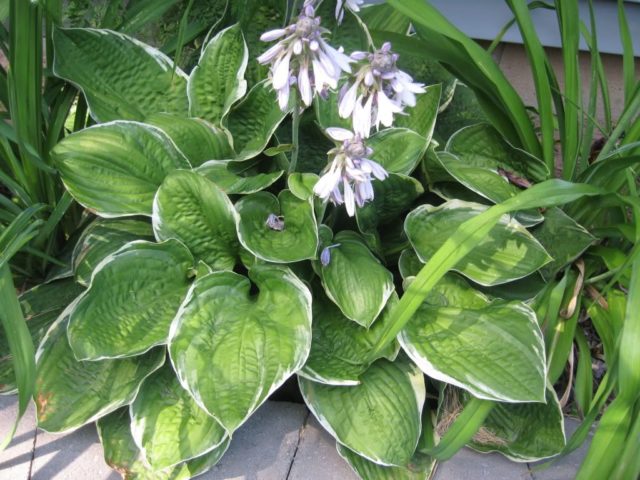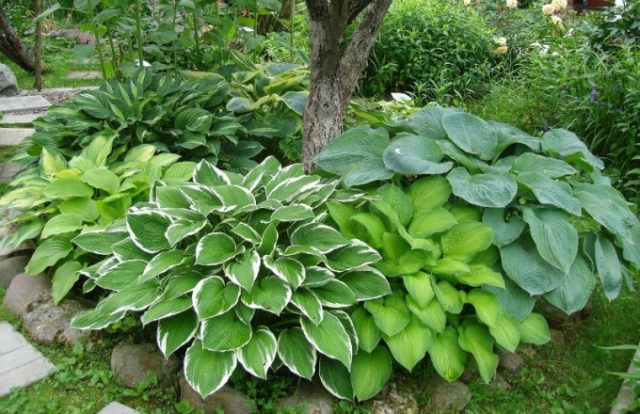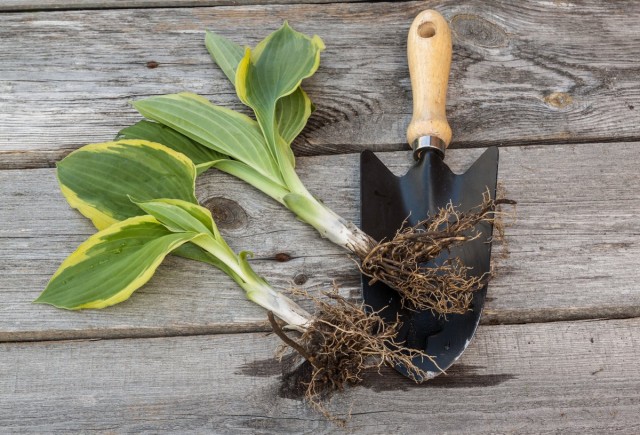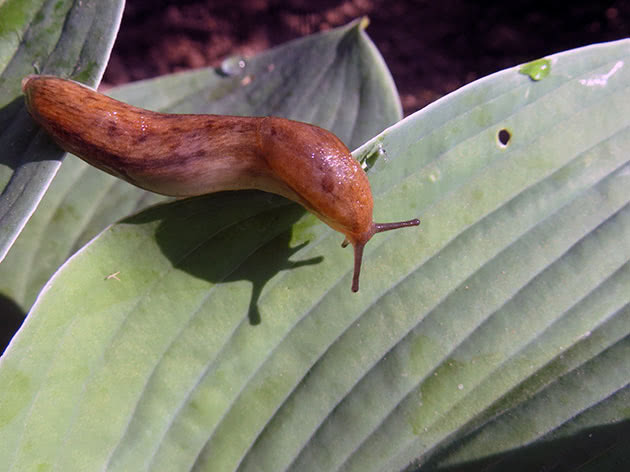Content
Hosta Christmas Tree, thanks to the unusual color of its wide leaves, is an excellent decoration for any garden plot. With this variety, you can create various group landscape compositions or single plantings. In addition, "Christmas Tree" retains its decorative effect throughout the season, therefore it is popular among gardeners. However, in order for the host to feel well, you should choose the right place for planting, observe the cultivation technique and correctly combine it with other inhabitants of the site.
Description of Christmas tree hosts
Khosta "Christmas Tree" is a perennial herb, which is a member of the Asparagus family, and also one of the most popular and well-known varieties of the species. Although not so long ago, many scientists began to attribute it to the lily family. Its varietal name "Christmas Tree" was given in honor of the Christmas tree, thanks to its bright green foliage.

The shrub prefers to grow near water bodies and rivers
Moderately corrugated round leaf plates with a sharp tip and a heart-shaped base. Along the edge there is an uneven creamy white border, in early spring a little yellowish. Hosta leaves, 21x16 cm in size, are matte, smooth, covered with a whitish bloom on the reverse side. The short petioles are dark green in color, and the rosette has a thin white outline. The bush "Christmas Tree" reaches a height of 40-50 cm, in width it grows up to 90 cm.
The hosta has a persistent color of greenery, which practically does not change, regardless of the place of planting or the season. Therefore, "Christmas Three" always retains its decorative effect throughout the season.
Hosta blooms in July-August, throwing out white, lavender-tinged, bell-shaped flowers collected in a brush on peduncles 35-45 cm long.
"Christmas Tree" is a frost-resistant variety and can withstand temperatures as low as -40 degrees. Therefore, the host can be planted in the northern strip of Russia, in the Urals and the Caucasus.
Application in landscape design
Hosta Christmas Tree is great for planting along curbs, alleys and garden paths. It is also often used to create a green background in flower beds with brightly blooming crops. Having neat rosettes and not being distinguished by rapid growth, it retains its decorative effect for a long time.

The plant is used to decorate lawns and flower beds.
The host can be paired with a wide variety of garden flowers. The only thing to consider when planting is the spreading of the bushes. Growing up "Christmas Tree" can close its neighbors from the sunlight. The hosta looks good against the background of tall plants: peonies, gladioli, ferns, hibiscus and arabis. They create light shading for the host, which protects its foliage from sunburn.
In addition to light-loving, stunted ground covers should not be planted next to "Christmas Tree", since its wide leaves will prevent moisture from penetrating to their roots. Also, it is undesirable for the host to be placed next to crops with an aggressive root system: phlox, lavender, primrose, bergenia.
Breeding methods
Hosta "Christmas Tree", like many herbaceous plants, can be propagated vegetatively (that is, with the remainder of a particle of the mother plant) and seed.
There are three main methods:
- dividing the bush;
- cuttings;
- sowing seeds.

Before planting, planting material can be stored in the dark at a temperature of +10 ° С
Reproduction of the hosta by dividing the bush is more preferable, since, firstly, young plants fully inherit the characteristics of the variety. And secondly, this method is the simplest and least laborious.
Landing algorithm
Seedlings should be planted in open ground only after the threat of spring frosts has completely disappeared. Hosta is usually planted in late April or early May. It is important to choose the right site for the plant's permanent residence. Christmas Tree prefers loose, well-drained and highly fertile soils. It is necessary that the soil is moisture permeable and breathable. For this purpose, sandy loam soils with neutral or slightly acidic pH values are most suitable.
Before planting, the garden bed should be dug to the depth of the shovel bayonet, simultaneously introducing organic fertilizers (humus, compost).
In order for the seedlings of the "Christmas Three" hosts to take root better and not get sick, it is necessary to choose high-quality planting material. Young plants should be healthy and have at least 3-4 buds. It is necessary that the root system is well developed with roots at least 10-12 cm long. They must also have a healthy appearance, be firm and elastic to the touch.
If the planting material is sold in pots, you should pay attention to the condition of the soil. The soil should be clean, slightly damp and free of mold.
Landing Algorithm:
- In a previously prepared area, make holes 30 cm deep at a distance of 80-100 cm from each other.
- Moisten each hole and lay a drainage layer 4-5 cm high on the bottom to exclude stagnation of water at the plant roots.
- In the case of purchasing seedlings in pots, it is necessary to fill it with water to better extract the earthy coma. If the root system of the hosta is bare, carefully examine it and remove damaged and dry roots.
- Two-thirds of the planting pit should be filled with a substrate of peat and humus (1: 1).
- Place the seedling in the center of the hole, lay the roots, straightening them in a horizontal plane.
- Fill the hole with soil, lightly tamping it with your hand so that there are no voids left.
- Water the hosta seedlings abundantly with settled water and mulch the flower bed with peat to retain moisture.
Exact adherence to the sequence of actions when planting "Christmas Tree" favorably affects the survival rate and adaptation of young plants in a new place.
Growing rules
Caring for the Christmas Tree host is not difficult and does not take much time, so even novice gardeners can do it. It is enough to regularly water the bushes, loosen and rid the soil of weeds, and also adhere to the feeding schedule.
Christmas Tree likes the soil in which it grows to always be slightly moist. Usually, flower beds are watered 3-4 times a week, as the topsoil dries out. During dry periods, watering should be done almost every day. It is advisable to do this in the early morning or evening, before sunset, watering the hosta at the root. Getting on the leaves, moisture will drain into the center of the outlet, which will lead to rotting of the bush.
If the hosta planting rules were followed (applying organic fertilizers to the flower beds and a special substrate in the planting pit), the plant does not need additional feeding for the first 3-4 years. Further, "Christmas Three" should be fertilized 3 times per season:
- In the spring - during active growth.
- In the summer - before flowering.
- Closer to the beginning of autumn, after flowering.

The plant grows better in partial shade
At the same time, complexes with an increased content of superphosphates, ammonium nitrate and potassium sulfate are introduced. You must try not to overfeed the bushes.
Because the Christmas Tree hosta loves breathable soil, the beds need to be loosened regularly to provide fresh air to the root system.Twice a season, fresh mulch should be poured under the bushes, removing the old one. This is done so that the soil does not compact and remains moist longer.
Preparing for winter
In order for Hosta Christmas Tree to spend the winter safely, you should take care of this in the fall. Preparation for winter consists in pruning the bush and providing timely shelter from frost.
Pruning - the process is not laborious and comes down to the removal of peduncles. This is necessary so that the hosta does not waste its energy on seed formation. It is not recommended to touch the foliage, as this will stress the plant. In the fall, it is impossible to remove dried leaves - they will serve as a natural covering material, usually this is done in the spring.
In regions with harsh winters, dead leaves are not enough for shelter from the piercing frosty winds. Therefore, the bushes are mulched with a layer of dry cut grass, rotten sawdust or peat.
Shrubs "Christmas Tree" can be additionally covered with a special covering material, simply by throwing it on top and pressing the edges to the ground with the help of stones.
The plant does not need winter feeding, the last time fertilization is applied in August. Hosta Christmas Tree naturally prepares for wintering.
Diseases and pests
Most often, "Christmas Tree" is affected by various diseases in the spring, being weakened after winter. This could be:
- sclerotinia - affects the root system;
- gray rot - plant leaves suffer;
- philostricosis - manifests itself as yellowish spots on the leaves.
All of these diseases are of fungal origin and are treated by spraying with fungicides or dichlorane.
For the Christmas Tree hosts, the most dangerous pest can be a slug. A sign of damage is holes in the leaf plates.

Often diseases appear due to excess moisture
Another, no less dangerous, enemy is nematodes. Their presence can be identified by characteristic spots on the leaf. And if you can easily get rid of slugs by simply leaving an open container of beer under the hosta bush, then the plant affected by nematodes will have to be removed and burned.
Conclusion
Hosta Christmas Tree is an ornamental deciduous plant, which is one of the brightest inhabitants of the infield. Hosta belongs to perennial slow-growing plants that do not require special conditions and special care. A correctly chosen place and a well-organized watering regime and a feeding schedule will allow you to easily grow a lush and variegated bush in your garden, pleasing the eye with lavender flowers.








